Cinco de Mayo
Cinco de Mayo (pronounced [ˈsiŋko ðe ˈmaʝo] in Mexico, Spanish for "Fifth of May") is a yearly celebration held on May 5 to celebrate Mexico's victory over the Second French Empire at the Battle of Puebla in 1862,[1][2] led by General Ignacio Zaragoza. Zaragoza died months after the battle from an illness, and a larger French force ultimately defeated the Mexican army at the Second Battle of Puebla and occupied Mexico City. However, following the end of the American Civil War in 1865, the United States began lending money and guns to the Mexican Liberals, pushing France and Mexican Conservatives to the edge of defeat. At the opening of the French chambers in January 1866, Napoleon III announced that he would withdraw French troops from Mexico. In reply to a French request for American neutrality, the American secretary of state William H. Seward replied that French withdrawal from Mexico should be unconditional.
| Cinco de Mayo | |
|---|---|
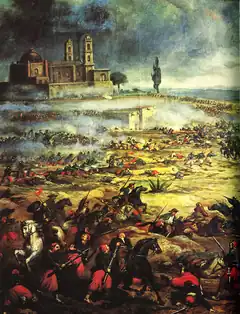 | |
| Observed by | Mexicans, Mexican Americans, and people of non-Mexican heritage |
| Type | Political |
| Significance | Celebration of the Mexican victory over French forces at the Battle of Puebla, on May 5, 1862 |
| Celebrations | Parades, food, music, folkloric dancing, battle reenactments |
| Date | May 5 |
| Next time | May 5, 2024 |
| Frequency | yearly |
| Related to | El Día de la Batalla de Puebla |
More popular in the United States than in Mexico,[3][4] Cinco de Mayo has become associated with the celebration of Mexican-American culture.[5][6][7] Celebrations began in Columbia, California, where they have been observed annually since 1862.[8] The day gained nationwide popularity beyond those of Mexican-American heritage in the 1980s due to advertising campaigns by beer, wine, and tequila companies; today, Cinco de Mayo generates beer sales on par with the Super Bowl.[9] In Mexico, the commemoration of the battle continues to be mostly ceremonial, such as through military parades or battle reenactments. The city of Puebla marks the event with various festivals and reenactments of the battle.
Cinco de Mayo is sometimes mistaken for Mexico's Independence Day—the most important national holiday in Mexico—which is celebrated on September 16, commemorating the Cry of Dolores in 1810, which initiated the war of Mexican independence from Spain.[1][10] Cinco de Mayo has been referenced and featured in entertainment media, and has become an increasingly global celebration of Mexican culture, cuisine, and heritage.
Background
Events leading to the Battle of Puebla
.png.webp)
Cinco de Mayo has its roots in the Second French intervention in Mexico, which took place in the aftermath of the 1846–48 Mexican–American War and the 1858–61 Reform War. The Reform War was a civil war that pitted Liberals (who believed in separation of church and state and freedom of religion) against Conservatives (who favored a tight bond between the Catholic Church and the Mexican state).[11] These wars nearly bankrupted the Mexican Treasury. On July 17, 1861, Mexican President Benito Juárez issued a moratorium in which all foreign debt payments would be suspended for two years.[6][12] In response, France, Spain, and the United Kingdom held a convention in London and joined in alliance to send naval forces to Veracruz to demand reimbursement. France, at the time ruled by Napoleon III, decided to use the opportunity to establish an empire in Mexico that would favor French interests, whereupon Britain and Spain negotiated with Mexico and peacefully withdrew. The empire was part of an envisioned "Latin America" (term used to imply cultural kinship of the region with France) that would rebuild French influence in the American continent and exclude Anglophone American territories.
French invasion and Mexican victory
Late in 1861, a well-armed French fleet attacked Veracruz, landing a large French force and driving President Juárez and his government into retreat.[13] Moving on from Veracruz towards Mexico City, the French army encountered heavy resistance from the Mexicans close to Puebla, at the Mexican forts of Loreto and Guadalupe.[14] The French army of 6,500–8,000[15][16][14] attacked the poorly equipped Mexican army of 4,000.[14][note 1] On May 5, 1862,[17] the Mexicans decisively defeated the French army.[18][19][20] The victory represented a significant morale boost to the Mexican army and the Mexican people at large[21][22] and helped to establish a sense of national unity and patriotism.[23]
Events after the battle
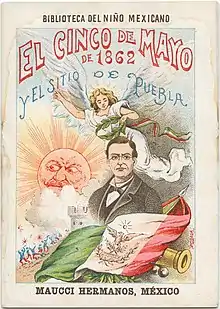
The Mexican victory, however, was short-lived. A year later, with 30,000 troops, the French were able to defeat the Mexican army, capture Mexico City, and install Emperor Maximilian I as ruler of Mexico.[14] The French victory was itself short-lived, lasting only three years, from 1864 to 1867.[14] By 1865, "with the American Civil War now over, the U.S. began to provide more political and military assistance to Mexico to expel the French."[14] Upon the conclusion of the American Civil War, Napoleon III, facing a persistent Mexican guerilla resistance, the threat of war with Prussia, and "the prospect of a serious scrap with the United States", retreated from Mexico starting in 1866.[24] The Mexicans recaptured Mexico City, and Maximilian I was apprehended and executed, along with his Mexican generals Miguel Miramón and Tomás Mejía Camacho in Cerro de las Campanas, Querétaro.[12][14] "On June 5, 1867, Benito Juárez entered Mexico City where he installed a new government organizing his administration."[12]
Significance
The Battle of Puebla was significant, both nationally and internationally, for several reasons. First, "This battle was significant in that the 4,000 Mexican soldiers were greatly outnumbered by the well-equipped French army of 8,000 that had not been defeated for almost 50 years."[25][26][note 2] Second, since the overall failed French intervention, some have argued that no country in the Americas has subsequently been invaded by any other military force from Europe.[27][note 3] Historian Justo Sierra has suggested in his Political Evolution of the Mexican People that, had Mexico not defeated the French in Puebla on May 5, 1862, France would have gone to the aid of the Confederate States of America in the American Civil War and the United States' destiny could have been different.[28][29]
History of the holiday
Mexico
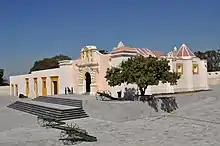
On May 9, 1862, President Juárez declared that the anniversary of the Battle of Puebla would be a national holiday regarded as "Battle of Puebla Day" or "Battle of Cinco de Mayo".[30][31][32][33][34]

The national celebration of the day peaked during the Porfiriato, the long rule of President/dictator Porfirio Díaz, who had fought in the Battle of Puebla as a young officer. According to historian Kelly Lytle Hernández, Díaz "strategically turned the Cinco de Mayo Festival or celebration into a celebration of his power and his reign and made it something that was celebrated across Mexico and even in diasporic Mexican communities in the United States."[35] Because of this association, in much of Mexico, Cinco de Mayo celebrations declined after Díaz was deposed in the Mexican Revolution.
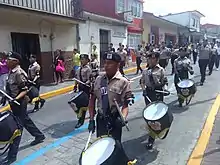
Today, the commemoration of the battle is not observed as a national holiday in Mexico (i.e. not a statutory holiday).[36] However, all public schools are closed nationwide in Mexico on May 5.[37][38] The day is an official holiday in the State of Puebla, where the Battle took place, and also a full holiday (no work) in the neighboring State of Veracruz.[39][40]
In Puebla, historical reenactments, parades, and meals take place to commemorate the battle. Parade participants dress as French and Mexican soldiers to reenact the battle.[41] Every year the city also hosts the Festival Internacional de Puebla, which gathers national and international artists, traditional musicians and dancers,[41] as well as the Festival Internacional del Mole, with an emphasis on the city's iconic mole poblano.[41]
In Mexico City, military commemoration is occasionally held at the Campo Marte.[42] A street, Avenida Cinco de Mayo, in the Historic Center of Mexico City was named after the battle in 1862 by Benito Juárez.
United States
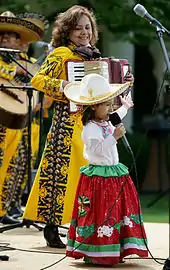
According to a paper published by the UCLA Center for the Study of Latino Health and Culture about the origin of the observance of Cinco de Mayo in the United States, the modern American focus on that day first started in California in 1863 in response to the resistance to French rule in Mexico.[43] "Far up in the gold country town of Columbia (now Columbia State Park) Mexican miners were so overjoyed at the news that they spontaneously fired off rifle shots and fireworks, sang patriotic songs and made impromptu speeches."[44]

A 2007 UCLA Newsroom article notes that "the holiday, which has been celebrated in California continuously since 1863, is virtually ignored in Mexico."[43] Time magazine reports that "Cinco de Mayo started to come into vogue in 1940s America during the rise of the Chicano Movement."[22] The holiday crossed over from California into the rest of the United States in the 1950s and 1960s but did not gain popularity until the 1980s when marketers, especially beer companies, capitalized on the celebratory nature of the day and began to promote it.[45][46] It grew in popularity and evolved into a celebration of Mexican culture and heritage, first in areas with large Mexican-American populations, like Los Angeles, Chicago, Houston, New York, followed by Cleveland, Boston, Indianapolis, Raleigh, Dallas, San Antonio, Washington, D.C., Atlanta, Miami, Orlando, Denver, Phoenix, Philadelphia, Tucson, San Francisco, San Jose, and San Diego.[47]
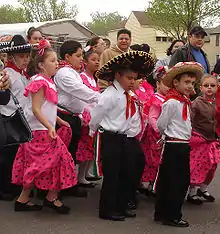
In a 1998 study in the Journal of American Culture it was reported that there were more than 120 official US celebrations of Cinco de Mayo in 21 different states. An update in 2006 found that the number of official Cinco de Mayo events was 150 or more, according to José Alamillo, a professor of ethnic studies at Washington State University in Pullman, who has studied the cultural impact of Cinco de Mayo north of the border.[48] Los Angeles' Fiesta Broadway has been billed as the largest Cinco de Mayo celebration in the world, which it most certainly was at its peak in the 1990s when it attracted crowds of 500,000 or more. In recent years attendance has seen a dramatic decrease.[49][50]
On June 7, 2005, the United States Congress issued a concurrent resolution calling on the President of the United States to issue a proclamation calling upon the people of the United States to observe Cinco de Mayo with appropriate ceremonies and activities.[51] To celebrate, many display Cinco de Mayo banners while school districts hold special events to educate students about its historical significance. Special events and celebrations highlight Mexican culture, especially in its music and regional dancing. Examples include baile folklórico and mariachi demonstrations held annually at the Plaza del Pueblo de Los Ángeles, near Olvera Street. Commercial interests in the United States have capitalized on the celebration, advertising Mexican products and services, with an emphasis on alcoholic beverages,[52][53] foods, and music.[54][55] According to Nielsen, in 2013 more than $600 million worth of beer was purchased in the United States for Cinco de Mayo, more than for the Super Bowl or St. Patrick's Day.[9]
The May 4, 2023 edition of The Washington Post publicized an article describing the holiday of Cinco de Mayo as an American holiday with Mexican roots and not necessarily a Mexican Holiday.[56]
Elsewhere
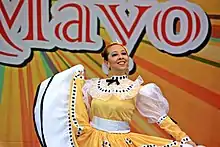
Events tied to Cinco de Mayo also occur outside Mexico and the United States. As in the United States, celebrations elsewhere also emphasize Mexican cuisine, culture and music. For example, some Canadian pubs play Mexican music and serve Mexican food and drink,[57] and a sky-diving club near Vancouver holds a Cinco de Mayo skydiving event.[58] In the Cayman Islands, in the Caribbean, there is an annual Cinco de Mayo air guitar competition,[59] and at Montego Bay, Jamaica, there is a Cinco de Mayo celebration.[60] The city of Brisbane, Queensland, Australia, holds an annual Mexican Festival[61] to honor the day, and celebrations are held in London[62] and New Zealand.[63] Other celebrations of the day can also be found in Cape Town, South Africa,[64] Lagos, Nigeria,[65] and in Paris, France.[66] Cinco de Mayo is celebrated in Japan in Osaka and in Tokyo's Yoyogi Park Event Space as a celebration of Latin American culture.[67][68][69]
See also
- List of occasions known by their dates
- Siege of Puebla (1863), fall of Puebla to the French
- Third Battle of Puebla (1867), recapture of Puebla and decisive victory for the restoration of the Republic.
Notes
- According to Mexico's National Institute of Historical Studies on the Mexican Revolution the Mexican force consisted of 4,802 soldiers. Archived October 6, 2012, at the Wayback Machine And Peter Hicks of the French Foundation Napoléon and other French sources state the size of the Mexican force was 12,000 men. . Hayes-Batista clarifies on page 60 of his El Cinco de Mayo: An American Tradition that after the smaller Mexican force had defeated the French on May 5, they received reinforcements on May 6 and 7 of approximately 12,000 additional Mexican soldiers.
- It has been pointed out that, contrary to reports on PBS and in Philadelphia's The Bulletin, the French were in fact considered to have been defeated by the Russians at the Siege of Petropavlovsk in 1854.
- The statement in The Bulletin is, "This was the last time any army from another continent invaded the Americas."[25] Note it says "invaded", and not "attacked". Thus, since Cinco de Mayo no army from another continent has invaded the Americas. The Falklands War, for example, was fought in the Americas but the Islands were invaded by a military from the Americas (the Argentine military). They were subsequently defended (not invaded) by the UK. Another example, Pearl Harbor, experienced an attack, not an invasion by the Japanese. The only possible exception to the Cinco de Mayo claim above might be the brief occupation/invasion of two of the Alaskan Aleutian Islands by the Japanese military during WWII. This event, however, was so insignificant as to be virtually negligible: the islands invaded had a total population of 12 Americans and some 45 natives, the invasion was short-lived, and the battle fought there had no notoriety other than the psychological effect on the Americans that the Japanese had invaded American territory again (Alaska was not yet a full-fledged state). In short, the military importance of these small pieces of land was nowhere comparable to the superior military significance of the Battle of Puebla.
References
- Lovgren, Stefan (May 5, 2006). "Cinco de Mayo, From Mexican Fiesta to Popular U.S. Holiday". National Geographic News.
- "Recognizing the Significance of Cinco de Mayo". Congress.gov. House of Representatives. May 4, 2009. Retrieved May 1, 2017.
- "Cinco de Mayo has become a day for celebrating Mexican culture in the United States, and celebrations there easily outshine those in Mexico". About.com. Retrieved May 8, 2007.
- Greene, Brian (May 4, 2012). "Why is Cinco de Mayo More Popular in America Than in Mexico?". U.S. News & World Report. Retrieved May 6, 2023.
- Krogstad, Jens (May 5, 2003). "University community celebrates Cinco de Mayo". The Minnesota Daily. University of Minnesota. Archived from the original on November 18, 2007. Retrieved April 25, 2016.
Today, the holiday is celebrated more in the United States than in Mexico
- "Cinco de Mayo". University of California at Los Angeles. Archived from the original on April 8, 2006. Retrieved May 5, 2011.
- "Cinco de Mayo celebrations run all weekend". Deseret News. Archived from the original on September 30, 2007. Retrieved May 8, 2007.
- Hayes-Bautista, David E. (April 2009). "Cinco de Mayo: The Real Story". EGP News. Eastern Group Publications. Archived from the original on June 12, 2016. Retrieved June 2, 2016.
Far up in the gold country town of Columbia (now Columbia State Park) Mexican miners were so overjoyed at the news that they spontaneously fired off rifles shots and fireworks, sang patriotic songs and made impromptu speeches.
- "What Is Cinco de Mayo?". The New York Times. May 5, 2018. Retrieved May 6, 2018.
- Lauren Effron (May 5, 2010). "Cinco de Mayo: NOT Mexico's Independence Day". Discovery Channel. Archived from the original on May 8, 2010. Retrieved May 6, 2023.
- Minster, Christopher (December 16, 2013). "Cinco De Mayo/The Battle of Puebla". About.com. Retrieved April 25, 2016.
- Herz, May. "Cinco de Mayo". Inside Mexico. Retrieved May 5, 2011.
- "Cinco de Mayo". History.com. Retrieved May 5, 2011.
- "Cinco de Mayo". Mexico Online. April 25, 2007. Retrieved May 5, 2011.
- Goralka, Julia (May 2, 2012). "Cinco de Mayo: What's all the fuss about?". The Washington Times. Retrieved November 15, 2012.
- Suarez, Ray (May 4, 2012). "Happy Cinco de Mayo – Sorta". PBS NewsHour. Retrieved October 28, 2012.
- "Cinco de Mayo". 2011. The History Channel website. Retrieved May 5, 2011.
- González, Ignacio (1996). "The Significance of 'Cinco de Mayo'". Retrieved November 15, 2012.
- Azios, Tony (2010). "Cinco de Mayo – The Backstory". Llero.net. Jaws Communication. Archived from the original on May 13, 2013. Retrieved November 15, 2012.
- VanBuskirk, Cheryl (May 7, 2009). "Cinco De Mayo: Join In The Celebration On The Fifth Of May". The Bulletin. Archived from the original on May 11, 2009. Retrieved May 10, 2010.
- "Cinco de Mayo". HistoryChannel.com. Retrieved May 14, 2010.
- Romero, Frances (May 5, 2010). "Happy Cinco de Mayo: Top 10 Drunkest Holidays". Time. Archived from the original on May 7, 2010. Retrieved May 14, 2010.
- "Cinco de Mayo". Mexico Online. April 25, 2007. Retrieved May 5, 2011.
- Michael C. Meyer; William H. Beezley (2000). The Oxford History of Mexico. Oxford University Press. pp. 387–8. ISBN 9780195112283.
- "Cinco De Mayo: Join In The Celebration On The Fifth Of May". Archived May 11, 2009, at the Wayback Machine Cheryl VanBuskirk. The Bulletin. Philadelphia, Pennsylvania, US. May 7, 2009. Retrieved June 5, 2009.
- "The Battle of Puebla and Cinco de Mayo". PBS. Retrieved February 6, 2009.
- "Cinco De Mayo: Join In The Celebration On The Fifth Of May". Archived May 11, 2009, at the Wayback Machine Cheryl VanBuskirk. The Bulletin, May 7, 2009. Retrieved June 5, 2009.
- "Mexico's Lasting European Influence. By Jose Antonio Burciaga. Free Lance-Star Publishing. May 2007. (First released in The Hispanic News Link. 1981.)". Banderasnews.com. Retrieved May 5, 2011.
- Robert L. Bidwell (April 1971). "The Political Evolution of the Mexican People. By Justo Sierra. Translated by Charles Ramsdell. Austin, TX: The University of Texas Press. 1969". Journal of Interamerican Studies and World Affairs. Center for Latin American Studies at the University of Miami. 13 (2): 306–308. doi:10.2307/174689. JSTOR 174689.
- "Did You Know? Cinco de Mayo is more widely celebrated in USA than Mexico". Tony Burton. Mexconnect. Retrieved May 8, 2013.
- "Cultural adaptation: the Cinco de Mayo holiday is far more widely celebrated in the USA than in Mexico". Geo-Mexico. May 2, 2011. Retrieved May 8, 2013.
- "25 Latino Craft Projects: Celebrating Culture in Your Library". Ana Elba Pabon. Diana Borrego. 2003. American Library Association. Page 14. Retrieved May 8, 2013.
- "7 Things You May Not Know About Cinco de Mayo". Jesse Greenspan. May 3, 2012. Retrieved May 8, 2013.
- Congressional Record – House. Page 7488. 9 May 2001. Retrieved May 8, 2013. Contrary to most other sources, this source states the date Juarez declared Cinco de Mayo to be a national holiday was September 8, 1862.
- "Cinco de Mayo and the Rise of Modern Mexico : Throughline". NPR.
- "Holidays 2013". Archived May 13, 2013, at the Wayback Machine U.S. Consulate in Mexico. Retrieved April 16, 2013.
- Los días de 2013 que, por ley, debes descansar. January 9, 2013. Retrieved April 16, 2013.
- Calendario Escolar 2012–2013. Archived April 13, 2013, at the Wayback Machine Secretaria de Educacion Publica. Government of Mexico. Retrieved April 16, 2013.
- Calendario Puebla 2012. Retrieved April 16, 2013.
- Circular 0077-13 Calendario Oficial de Días Festivos 2013. Adelante. Gobierno del Estado de Veracruz. January 16, 2013. Retrieved April 16, 2013.
- "How people actually celebrate Cinco de Mayo in Mexico". Business Insider. Retrieved May 3, 2017.
- "Peña Nieto no estará en Puebla para desfile del 5 de Mayo; conmemora Batalla en Campo Marte". SDPnoticias.com (in European Spanish). May 5, 2015.
- Southern California Quarterly "Cinco de Mayo's First Seventy-Five Years in Alta California: From Spontaneous Behavior to Sedimented Memory, 1862 to 1937" Spring 2007 (see American observation of Cinco de Mayo started in California) Retrieved October 30, 2007.
- Hayes-Bautista, David E. (April 2009). "Cinco de Mayo: The Real Story". EGP News. Eastern Group Publications. Archived from the original on June 12, 2016. Retrieved June 2, 2016.
Far up in the gold country town of Columbia (now Columbia State Park) Mexican miners were so overjoyed at the news that they spontaneously fired off rifles shots and fireworks, sang patriotic songs and made impromptu speeches.
- "Cinco de Mayo minor holiday in Mexico". UPI. World News. May 5, 2010. Retrieved May 15, 2010. Verified March 20, 2013.
- Cesares, Oscar (May 5, 2010). "Holiday of Cinco de Mayo is minor event in Mexico". Houston Chronicle. Retrieved May 15, 2010.
- "Cinco de Mayo". History.com. Retrieved March 10, 2013.
- Lovgren, Stefan. "Cinco de Mayo History: From Bloodshed to Beer Fest". National Geographic. Los Angeles. Retrieved May 5, 2011.
- Canalis, John (April 26, 1992). L.A. hosts nation's biggest Cinco de Mayo party. UPI Archives. Retrieved August 22, 2016.
- Jamison, Peter (April 24, 2016). "With thinner crowds in a smaller space, Fiesta Broadway feels deeply diminished". Los Angeles Times. Retrieved August 22, 2016.
- Library of Congress (U.S.A.) Declaration Archived September 2, 2014, at the Wayback Machine. Retrieved February 6, 2009.
- Kane, Courtney (May 2, 2003). "Marketers extend their holiday efforts to a Mexican celebration and even to Lent". The New York Times. Retrieved April 25, 2016.
[Cinco de Mayo] gives us an opportunity ... to really get a jump-start on the summer beer-selling season
- "Constellation Brands and Crown Imports Ring in Cinco de Mayo at New York Stock Exchange". ACNNewswire.com. Victor, New York: Asian Corporate News Network. May 3, 2012. Retrieved May 8, 2012.
- Salem, Nancy (May 4, 2007). "Cinco de Mayo's history neglected; it's an excuse to party". The Albuquerque Tribune. Archived from the original on September 14, 2007. Retrieved April 25, 2016.
From my perspective as a marketing professional, Cinco de Mayo has morphed into a national holiday designed by Fifth Avenue to sell alcohol and excite consumership around a party-type theme
- Alamillo, José M. "Contesting Cinco de Mayo: Cultural Politics and Commercialization of Ethnic Festivals, 1930–1950". Smithsonian Institution. Archived from the original on May 10, 2010. Retrieved May 8, 2007.
Cinco de Mayo is not just a fiesta anymore, the gringos have taken it on as a good sales pitch
- Kinnally, Cara Anne (May 5, 2023). "Cinco de Mayo is not a Mexican holiday. It's an American one". The Washington Post. Retrieved May 12, 2023.
- Canadian celebration Archived August 27, 2012, at the Wayback Machine; St. Albert, Canada 2012 celebration Archived June 22, 2012, at the Wayback Machine; Montreal celebration. Retrieved May 8, 2012.
- "Cinco de Mayo Skydiving Boogie 2008". Abbotsford, British Columbia, Canada. Archived from the original on April 19, 2008. Retrieved May 5, 2008.
- Cayman Cinco de Mayo air guitar Archived January 16, 2015, at the Wayback Machine. Retrieved May 5, 2008.
- Jamaica celebration Archived July 18, 2012, at the Wayback Machine. Retrieved May 8, 2012.
- "Brisbane Cinco de Mayo Mexican Festival"; Brisbane celebration Archived July 9, 2012, at the Wayback Machine
- "Where to Celebrate Cinco de Mayo in London". Retrieved May 8, 2012.
- Mexican Ambassador to New Zealand honors Cinco de Mayo. Retrieved May 8, 2012.
- Cinco de Mayo in South Africa Retrieved May 5, 2016
- Cinco de Mayo in Lagos, Nigeria Archived June 4, 2016, at the Wayback Machine Retrieved May 5, 2016
- "El cinco de mayo – Paris – jeudi 05 mai" After Work. Retrieved May 8, 2012.
- Cinco de Mayo festivals in Osaka and Tokyo Archived May 5, 2016, at the Wayback Machine Retrieved May 5, 2016
- "Cinco De Mayo Festival in Tokyo" Archived February 22, 2014, at the Wayback Machine JapanBases.com. Retrieved August 16, 2013.
- "Cinco de Mayo 2013: Celebrating the Americas" Cinco de Mayo Festival. Retrieved August 16, 2013.
External links
- Cinco De Mayo Videos on The History Channel
- Cinco De Mayo Quick Facts
- "Cinco de Mayo is NOT Mexican Independence Day?" on The Law Library of Congress's blog
- "Origin of the Cinco De Mayo celebration" – Mexican American News / Xcano Media
- The Real Meaning Behind Cinco de Mayo, and Why Mexicans Don't Really Celebrate the Date